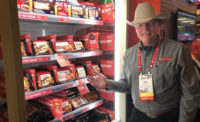The difference between North America and Europe is more than just geographical. There are many cultural differences as well. In the culinary world, one notable difference between Europeans and Americans is veal consumption. While veal remains a popular protein in European countries, its consumption has declined noticeably in the United States. The European meat industry is hoping to reverse that trend, which would benefit not only them but also the American veal industry.
Frans van Dongen, Director of International Affairs at the Dutch Meat Industry Association (COV), notes that veal is still thought of as the “little brother” of beef in Europe. However, he notes, the protein “has a strong position in certain eating cultures especially in the Mediterranean cuisine (Italian cuisine, French cuisine) and in cultures where they do not consume pork, but want to have a 'lighter' meat product than beef.”
Veal consumption is part of Europe’s cultural heritage. Many famous Italian and French dishes are made of veal such as Osso Buco, Saltimbocca, Blanquette de Veau and Ris de Veau (veal sweetbread). In a recent survey, Blanquette de Veau (a veal stew) was chosen by French consumers as France's most favorite dish. Even in Quebec, which is a part of North America with a strong European influence, veal is frequently eaten.
There are several reasons for veal’s popularity, van Dongen points out. “Veal is light-colored, tender and easy to digest. It is lean and low in calories and unsaturated fat,” he says. “Next to that, the European veal industry has invested a lot over the last decades in food safety, quality, traceability, self-control guarantees and especially animal welfare. All these are important selling points for veal.”
In the United States, it is a different story. In 1996, veal consumption in the United States totaled 379 million pounds. That number has dropped about 75 percent today to 90 million pounds; just within the last 10 years consumption fell 40 percent. Van Dongen attributes much of that to a decline in domestic production, adding that the veal industry is often unable to compete with the beef industry for the young calves that result from dairy production. He adds that the industry itself was slow to react to changes.
“The U.S. veal industry did not develop as strongly and sophisticated as the European industry over this period of time in order to remain a modern, strong and competing industry,” he explains.
The Dutch Meat Industry Association’s goal is to increase veal consumption in the United States. Part of that goal is to make European veal more visible to importers, distributors, foodservice and retail customers, particular if there is a shortage of domestic veal or customers need to order product in large volumes. The end result would be an increased market share of veal in U.S. consumption, but the winners wouldn’t be just the European veal industry.
“It is not our ambition to take away a share of the market volumes of the domestic US producers, but to create larger shares for both of us. There is much more potential for veal in the US market than is reflected by the actual figures,” van Dongen says.
The most promising market for veal is the East Coast, which has traditionally had a good veal consumption rate. While the logical focus would be on Italian restaurants, van Dongen wants to target less traditional restaurants, where veal would be the “Little brother” of the beef -- “The little special, interesting, appealing, cool brother in terms of quality and eating pleasure,” he adds.
Beyond that, he sees room in the burger category for veal, as an alternative to the beef burger.
“If we only could get a very small part of this market for veal burgers, that would be a great success,” he says. “We believe that especially in the higher-end burger market there should be place for special veal burgers, as an alternative for the everlasting beef burger. Diversification should be welcome in that market.”






